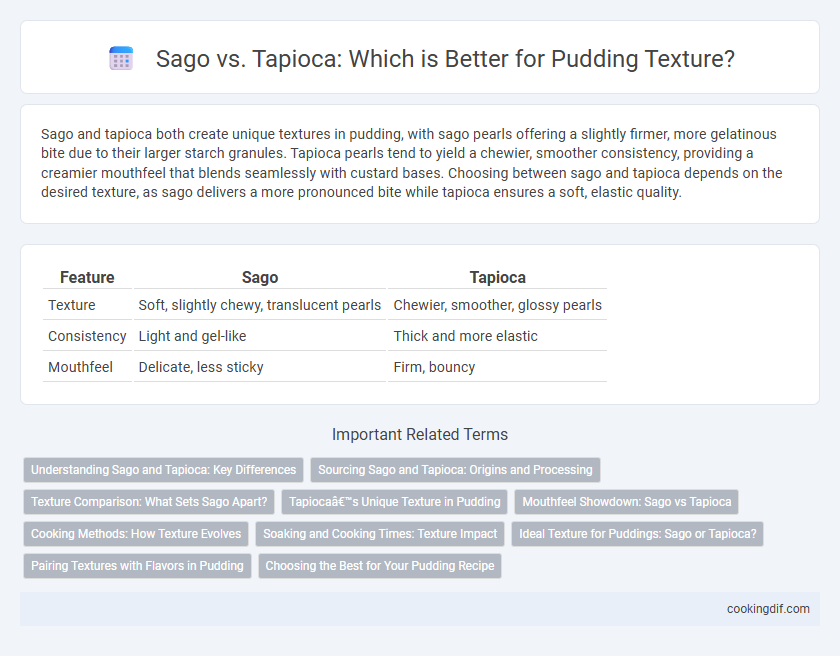Sago and tapioca both create unique textures in pudding, with sago pearls offering a slightly firmer, more gelatinous bite due to their larger starch granules. Tapioca pearls tend to yield a chewier, smoother consistency, providing a creamier mouthfeel that blends seamlessly with custard bases. Choosing between sago and tapioca depends on the desired texture, as sago delivers a more pronounced bite while tapioca ensures a soft, elastic quality.
Table of Comparison
| Feature | Sago | Tapioca |
|---|---|---|
| Texture | Soft, slightly chewy, translucent pearls | Chewier, smoother, glossy pearls |
| Consistency | Light and gel-like | Thick and more elastic |
| Mouthfeel | Delicate, less sticky | Firm, bouncy |
Understanding Sago and Tapioca: Key Differences
Sago and tapioca both originate from starchy plants but differ significantly in texture and culinary use; sago is derived from the pith of tropical palm stems, resulting in pearls that provide a more translucent, chewy texture, while tapioca comes from cassava root, producing pearls that are opaque and offer a smoother, creamier consistency. The size and preparation of sago pearls tend to create a lighter mouthfeel, often preferred in traditional puddings across Southeast Asia, whereas tapioca's versatility spans various desserts globally due to its ability to absorb flavors and thicken mixtures effectively. Understanding these differences aids in selecting the right starch for achieving the desired pudding texture and flavor profile.
Sourcing Sago and Tapioca: Origins and Processing
Sago is derived from the pith of tropical palm stems, predominantly sourced from Southeast Asia, where it undergoes traditional extraction and drying methods. Tapioca comes from the cassava root, primarily cultivated in South America and processed into starch through washing, pulping, and drying techniques. Both sago and tapioca offer distinct textural qualities in pudding, with sago providing a pearl-like chewiness and tapioca offering a smoother, more gelatinous consistency.
Texture Comparison: What Sets Sago Apart?
Sago pearls offer a unique, slightly chewy texture that remains firmer and less sticky compared to tapioca pearls, providing a distinct bite in puddings. Unlike tapioca, which becomes gelatinous and softer when cooked, sago's robust structure holds up better in longer cooking processes, resulting in a more defined mouthfeel. This textural difference makes sago ideal for puddings requiring a balance between chewiness and smoothness.
Tapioca’s Unique Texture in Pudding
Tapioca pearls create a distinctive, chewy texture in pudding that is both smooth and pleasantly bouncy, setting it apart from the firmer, more granular feel of sago. The translucent, gel-like consistency of tapioca enhances the creaminess of the pudding, providing a satisfying mouthfeel that balances softness with slight resistance. This unique texture makes tapioca-based puddings especially popular in desserts that emphasize a luxurious, velvety finish.
Mouthfeel Showdown: Sago vs Tapioca
Sago pearls deliver a light, chewy texture with a slightly firmer bite, creating a pleasantly bouncy mouthfeel in puddings. Tapioca pearls offer a smoother, more gelatinous consistency that melts gently, providing a creamy and tender sensation on the palate. The choice between sago and tapioca significantly influences the pudding's overall mouthfeel, with sago favoring resilience and tapioca enhancing creaminess.
Cooking Methods: How Texture Evolves
Sago pearls, derived from the pith of sago palm, develop a chewy, slightly gelatinous texture through prolonged boiling that allows the starch to fully gelatinize. Tapioca pearls, made from cassava starch, achieve a soft and bouncy consistency with shorter cooking times and rapid simmering techniques that prevent over-softening. The cooking method's duration and intensity directly influence the textural contrast between sago's resilient chewiness and tapioca's smooth, elastic bite in pudding recipes.
Soaking and Cooking Times: Texture Impact
Sago requires longer soaking and cooking times compared to tapioca, resulting in a chewier and more translucent pudding texture. Tapioca pearls cook faster and create a smoother, creamier consistency ideal for quick-prep puddings. Adjusting soaking and cooking durations directly influences the final mouthfeel and visual appeal of sago and tapioca-based desserts.
Ideal Texture for Puddings: Sago or Tapioca?
Sago pearls create a smoother, more gelatinous texture in puddings, offering a delicate mouthfeel that gently melts on the tongue. Tapioca pearls provide a chewier consistency with a slightly more pronounced bite, making the pudding more substantial and satisfying. Choosing between sago and tapioca depends on whether a silky, light pudding or a firmer, textured dessert is desired.
Pairing Textures with Flavors in Pudding
Sago pearls provide a chewy, slightly bouncy texture that contrasts beautifully with rich, creamy pudding bases, enhancing fruit-flavored or coconut-infused varieties. Tapioca pearls offer a smoother, more gelatinous mouthfeel, making them ideal to pair with vanilla or chocolate puddings where a silky complement is desirable. Selecting between sago and tapioca for pudding depends on the desired texture-flavor interaction, balancing chewiness with creaminess to elevate the overall sensory experience.
Choosing the Best for Your Pudding Recipe
Sago pearls provide a slightly chewier texture with a translucent appearance, ideal for traditional pudding recipes seeking an authentic feel. Tapioca pearls offer a smoother, more gelatinous consistency that easily absorbs flavors, making them perfect for creamy, rich puddings. Selecting between sago and tapioca depends on your desired mouthfeel and the specific pudding recipe, with sago favored for bite and tapioca for silkiness.
Sago vs Tapioca for texture Infographic

 cookingdif.com
cookingdif.com